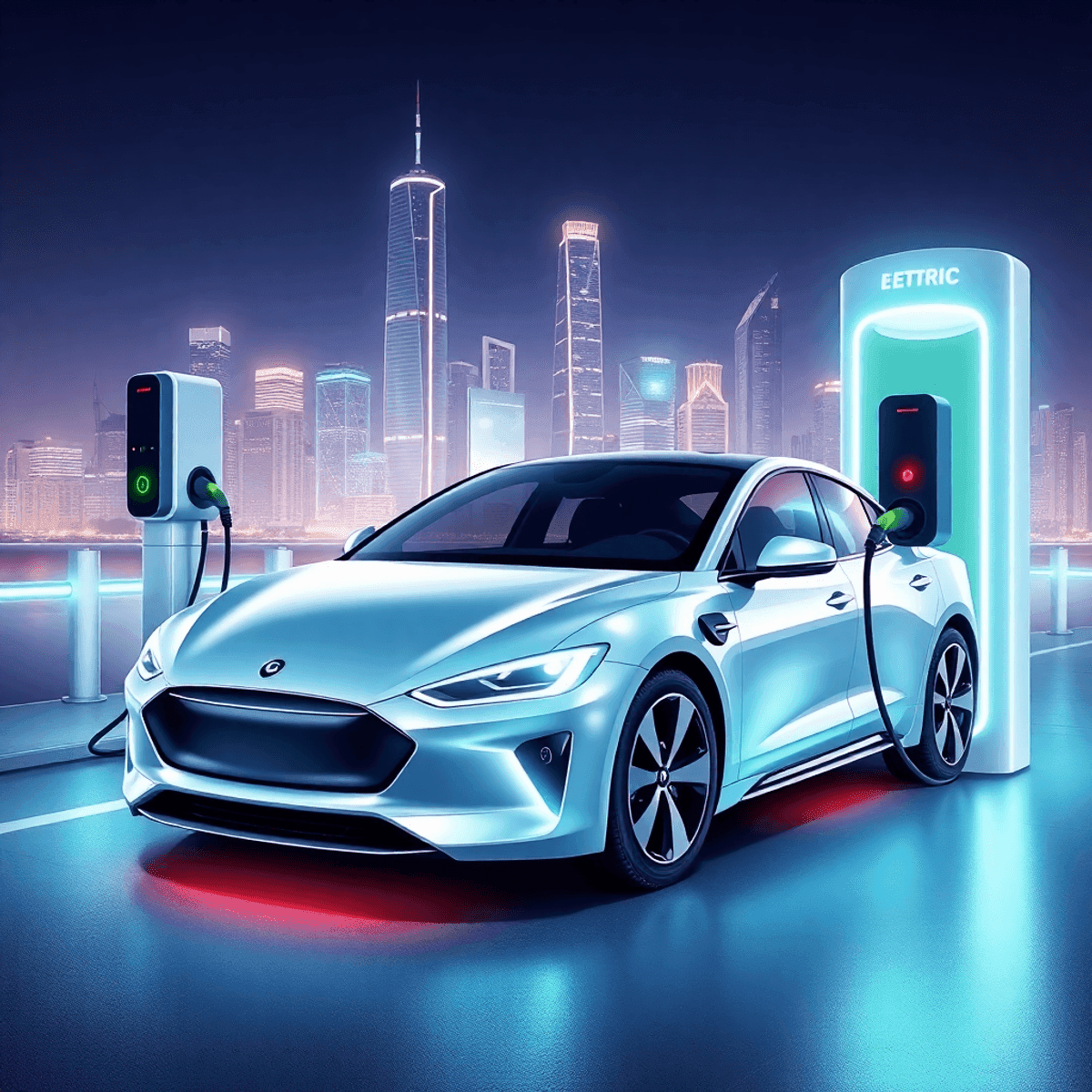Introduction
The rise of electric and self-driving cars signifies a pivotal shift in the automotive industry. As technology advances, these vehicles are becoming more integrated into daily life. Understanding these innovations is essential for both consumers and industries due to their potential impact on mobility, the environment, and the economy.
Key points to consider include:
- Electric cars offer an eco-friendly alternative to traditional gasoline vehicles, reducing emissions and dependency on fossil fuels.
- Self-driving cars promise enhanced safety, efficiency, and convenience by minimizing human error and optimizing traffic flow.
The market potential for these technologies is substantial. Projections indicate that by 2030, the market for robotaxis alone could surpass $25 billion. This forecast reflects not only advancements in technology but also growing consumer acceptance and regulatory support for autonomous vehicles. The convergence of electric powertrains and autonomous driving capabilities positions these vehicles at the forefront of automotive innovation, making it crucial for stakeholders to stay informed about their evolution.
The Current Landscape of Electric and Self-Driving Cars
Understanding the difference between electric and self-driving cars is crucial in today’s automotive world.
What Are Electric Cars?
These vehicles run on electricity, using batteries for power. They are environmentally friendly and help reduce emissions.
What Are Self-Driving Cars?
Also known as autonomous vehicles (AVs), these cars use advanced technology to navigate without human control.
Current Adoption Rates
Current adoption rates show a growing interest:
- Electric Vehicles (EVs) made up about 8% of global car sales in 2022, and they are expected to grow significantly.
- Autonomous Vehicles are still in the early stages, with only 1-2% of total global vehicle sales projected to have Level 3 features by 2026.
Understanding Level 2+ Cars
A key aspect of AVs is understanding Level 2+ cars, which include advanced driver assistance features. These vehicles can perform tasks such as:
- Adaptive cruise control
- Lane centering
- Automatic emergency braking
These features improve safety and convenience, laying the groundwork for higher levels of autonomy.
As technology continues to advance, consumer awareness and acceptance will be crucial in shaping the future of both electric and self-driving vehicles.
Advancements in AI Technology for Autonomous Vehicles
AI technology is a cornerstone of self-driving technology, enabling vehicles to perceive their surroundings, make decisions, and navigate complex environments.
1. Role of AI in Development
Self-driving cars rely heavily on machine learning algorithms to process data from sensors and cameras. This capability allows them to recognize pedestrians, traffic signals, and other vehicles, significantly enhancing safety and efficiency. Moreover, AI is making autonomous vehicles safer, which is a crucial aspect of their development.
2. Recent Advances in AI Scaling Techniques
Innovations in AI scaling have dramatically improved the performance of autonomous vehicles. By utilizing larger training datasets and enhanced model architectures, manufacturers can create more robust systems. These advancements lead to better real-time decision-making capabilities, allowing vehicles to respond more accurately to dynamic road conditions.
3. Future Developments
The horizon holds promising advancements in AI that could further elevate the capabilities of AVs. Research into neural networks and deep learning continues to progress, potentially leading to fully autonomous systems that can operate in virtually any driving scenario without human intervention. In fact, recent studies suggest that AI can enhance the efficiency of autonomous driving even when idle, which could revolutionize the way we think about vehicle operation.
These developments not only enhance vehicle functionality but also pave the way for broader adoption of autonomous technologies across various markets.
Global Adoption Trends: A Regional Perspective
The adoption of autonomous vehicles (AVs) varies significantly across different regions. By 2040, projections indicate notable differences in AV sales:
- China: Expected to lead global AV sales, with approximately 90% of all car sales being Level 3 or higher autonomous vehicles.
- Europe: Anticipated to see around 80% of car sales attributed to advanced AVs, reflecting strong regulatory support and consumer acceptance.
- United States: Predicted to achieve about 65% of car sales being advanced AVs, influenced by a combination of technological advancements and regulatory frameworks.
Several factors play a crucial role in these regional disparities:
- Regulatory Environment: Countries like China have embraced stricter regulations to expedite the deployment of AVs, while the US faces more fragmented regulations at the state level.
- Consumer Attitudes: Cultural perceptions toward technology adoption can impact acceptance rates. In regions where innovation is celebrated, such as China, AVs gain traction quicker than in areas with more skepticism.
- Infrastructure Investment: Areas with robust infrastructure for electric and self-driving cars tend to facilitate higher adoption rates.
As electric and self-driving cars continue to rise globally, the interplay of these factors will shape the future landscape of mobility.
The Role of Cost Reductions in Accelerating Autonomous Vehicle Adoption
A significant barrier to the widespread adoption of autonomous vehicles (AVs) is the cost of autonomous vehicles. Several factors contribute to the affordability of these vehicles for consumers:
- Hardware Costs: Advanced AVs require a variety of hardware components, including cameras and sensors. The integration of these technologies can significantly increase the upfront costs. Lowering these costs will be crucial for broader consumer access.
- Chipmakers’ Impact: Chipmakers are at the forefront of reducing hardware expenses. By advancing manufacturing processes, they are able to produce more powerful chips at lower prices. This reduction in cost directly influences the price of AV technology, making it more accessible.
- Sensor Technologies: The landscape of sensor technologies varies across different levels of automation:
- High-End Options: Level 4 and above often rely on sophisticated sensors like lidar, which can be expensive.
- More Affordable Alternatives: Level 2+ vehicles typically utilize multiple cameras and radar systems that are comparatively cheaper. As these technologies improve and scale, their costs are expected to decline further.
These advancements enable a shift towards more affordable AV options, fostering greater acceptance among consumers and paving the way for increased market penetration.
How Self-Driving Cars Will Transform the Ridesharing Industry
The rise of autonomous vehicles (AVs) will significantly reshape the ridesharing landscape. Key transformations include:
- Introduction of Fully Autonomous Robotaxis: As AV technology matures, ridesharing companies can deploy fleets of robotaxis, reducing reliance on human drivers.
- Cost Efficiency: Lower operational costs will attract more users, making ridesharing more affordable.
- Increased Accessibility: AVs will enhance mobility for individuals unable to drive due to age or disability.
- Enhanced Safety: With advanced sensors and AI, self-driving cars promise a reduction in accidents, benefiting both riders and operators.
This shift towards automation signals a profound impact on the ridesharing market from robotaxis.
Conclusion: Embracing an Autonomous Future with Electric Vehicles
The rise of electric and self-driving cars presents significant implications for both consumers and industries. Key benefits include:
- Reduced emissions: Electric vehicles contribute to a cleaner environment.
- Cost savings: Automation may lead to lower transportation costs.
- Enhanced safety: Advanced technologies aim to reduce accidents.
Challenges persist, including regulatory hurdles and public acceptance. As these technologies evolve, staying informed is essential. Understanding the landscape will empower consumers and industry stakeholders to navigate the opportunities and obstacles ahead in this transformative era. The future of mobility is here, positioning electric and self-driving cars at the forefront of change.
FAQs (Frequently Asked Questions)
What is the significance of electric and self-driving cars in today’s market?
Electric and self-driving cars are rapidly gaining traction, with a projected market potential of $25 billion for robotaxis by 2030. Understanding these technologies is crucial for consumers and industries as they reshape transportation.
How do electric cars differ from self-driving cars?
Electric cars are powered by electricity, while self-driving cars utilize advanced technology to operate autonomously. Some vehicles incorporate both features, offering electric power along with varying levels of automation.
What are Level 2+ driver assistance features in autonomous vehicles?
Level 2+ refers to vehicles equipped with advanced driver assistance features that enhance driving capabilities. These include adaptive cruise control and lane-keeping assistance, which contribute to the vehicle’s classification as semi-autonomous.
How does AI technology enhance self-driving capabilities?
AI plays a pivotal role in the development of self-driving technology by improving decision-making processes and vehicle performance. Recent advances in AI scaling techniques significantly enhance the functionality of autonomous vehicles.
What are the global trends in the adoption of electric and self-driving cars?
By 2040, significant variations in AV adoption rates are expected across regions like China, Europe, and the US, influenced by factors such as regulatory environments, consumer acceptance, and infrastructure readiness.
How will self-driving cars impact the ridesharing industry?
The widespread adoption of autonomous vehicles is set to transform the ridesharing landscape through the introduction of fully autonomous robotaxis. This shift promises to benefit consumers with lower costs and improved service efficiency for companies involved in ridesharing.








